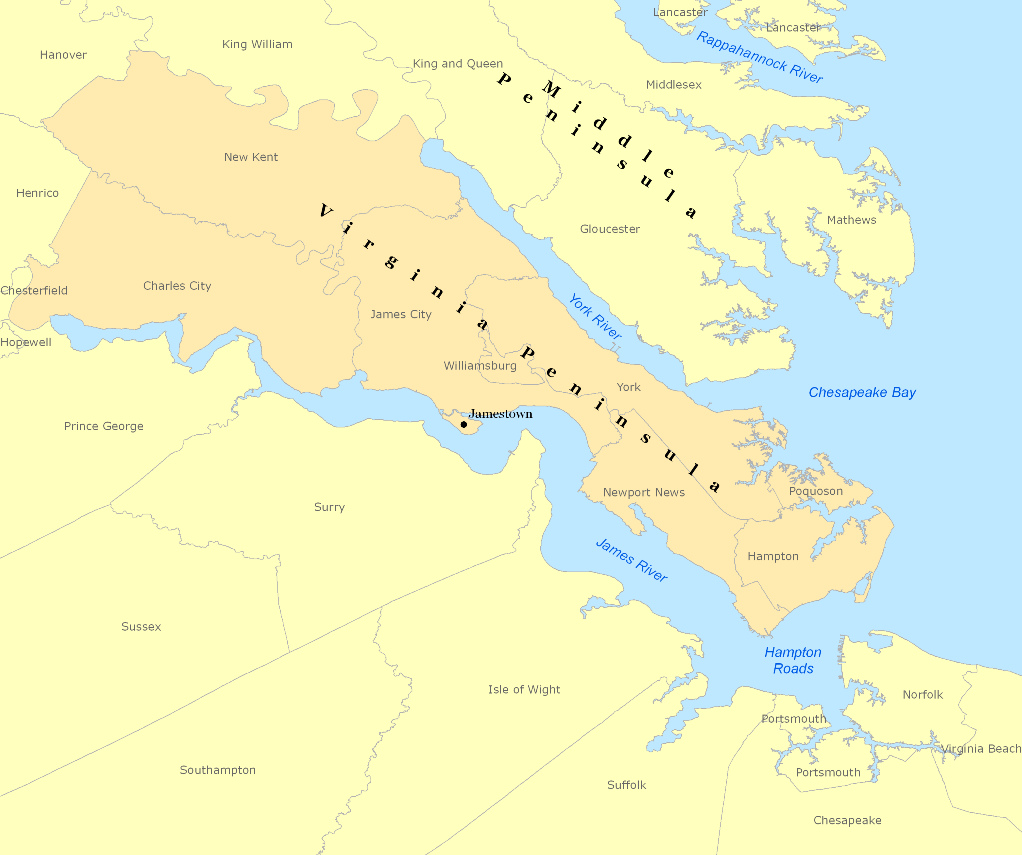I had the pleasure of serving as a parent chaperone for my son’s school field trip to Jamestown last week. Admittedly, the thought of accompanying two busloads of children aged nine-to-ten sounded a bit daunting. And of course it definitely had its challenges at times. I thought it was going to unfold like an uglier and much less enjoyable version of Weekend Roady but it turned out for the best. I’m not sure what magic the teachers possess but I’d like to get my hands on some of it. The little darlings behaved much better for their teachers than they’ve ever behaved for their parents.
We are a bit spoiled in a sense in the Washington, DC area. The kids take two or three field trips a year to various sites along the National Mall. Naturally this includes the full string of Smithsonian museums as well. That would be the “big trip” for many schoolchildren further afield. Maybe they might visit the Nation’s capital a single time in their pre-adult lives if they’re lucky.
The Virginia Peninsula
Fourth grade provides an opportunity to explore beyond the Beltway. The curriculum shifts to state history for the duration of the school year. This draws considerable attention to various sites along the Virginia Peninsula located between the James and York Rivers.

The students had been studying Jamestown, the first permanent English settlement in what would later become the United States. Now they were finally about to see it in person. Two buses rolled from the elementary school parking lot with military precision at exactly 7:00 am for the two and a half hour drive. We arrived just as the kids became restless with chatter starting to approach slightly unbearable volumes.
The original Jamestown Settlement of 1607 no longer exits. In fact, the original location was lost to history for centuries. Experts thought it had been submerged beneath the James River until archaeologists rediscovered it in 1996. Thus the current park is a best-guess estimate of the Jamestown Settlement and its surrounding environment. It’s presented in an easily digestible living-history format. In that sense it’s a lot like its adjacent neighbor, Williamsburg (my visit)
Into the Park
We left the buses and followed a tour led by docents. The weather happened to be stunningly perfect: sunny and about 60°f. (16°c.). It doesn’t get any better than that in Virginia in early December. It’s an odd time of year for a tour conducted primarily outdoors and it could have resulted in an entirely different outcome. We thanked our good fortune and pressed onward.
The Original Inhabitants
History curricula at these grade levels often begin with the arrival of Englishmen on the peninsula as if nothing else of consequence existed beforehand. The Algonquins of the Powhatan tribe might beg to differ. To the museum’s credit that is where the tour began.

The Powhatan Confederacy included some 15,000 people in numerous tributary groups located along the rivers of Virginia’s coastal plain. They lived in structures called yehakins built of woven mats tied to wooden frames of bent saplings. The society relied on farming and hunting, and they settled in stationary villages. No, the Powhatan were not nomads. Even today, four hundred years later, the Mattaponi and Pamunkey tribes of Powhatan Indians retain a remnant of their ancestral lands on Virginia’s Northern Neck.
Our students had an opportunity to tour through the yehakins, watch a cooking demonstration, scrape fur from a deer hide, learn about toolmaking, and pound dried corn into cornmeal.
Transportation

The tour shifted to the arrival of the English settlers on three ships: Susan Constant, Godspeed and Discovery. The leader of that original voyage was Captain Christopher Newport. The city of Newport News now carries his name.
I’ve seen reproductions of colonial-era ships before and their diminutive size always amazes me. It’s hard to imagine anyone taking something so small across an ocean. The one pictured above — the reproduced Susan Constant — is the largest of the three. Discovery measured less than forty feet long and yet carried twenty-one men on a open-ocean voyage lasting five months.
We also got a great view of the Jamestown-Scotland ferry unloading vehicles although I was probably the only person impressed by that.
The Fortification

Next we moved on to the settlement itself. It was a replica of the triangular fort built to protect inhabitants from Native Americans who’d become increasingly annoyed with trespassers and interlopers. Here I noticed a considerable gender difference within our little group of visitors. The girls seemed to find interests within the totality of the experience while the boys were all about the guns. It’s gender stereotyping, and yet, even at ages nine and ten the children seemed to fall within predictable camps.
We left precisely at 2:00. The teachers mollified their fidgeting hordes by playing a movie on the overhead screens (all other electronics being prohibited for the entire trip): Pocahontas. One can’t talk about Jamestown without mentioning Pocahontas, right? Even this small act hid an educational motivation behind it. The historical inaccuracies of the Disney version practically jumped from the screen when compared side-by-side to the day’s events. The children had great fun poking at various errors and gaffes, unprompted.
Being Dad
Of course I felt compelled to mention the My Little Poni paradox at an appropriate spot along the highway, resulting in an eye-roll from my son. What good is chaperoning if we can’t embarrass our own children in front of their peers? Otherwise the return trip was unremarkable and we arrived only ten minutes late. Anyone familiar with Washington, DC traffic on a Friday afternoon will realize that this was a minor miracle in itself.
I’m glad I went. I’m also glad it was only a one-day trip.

Leave a Reply